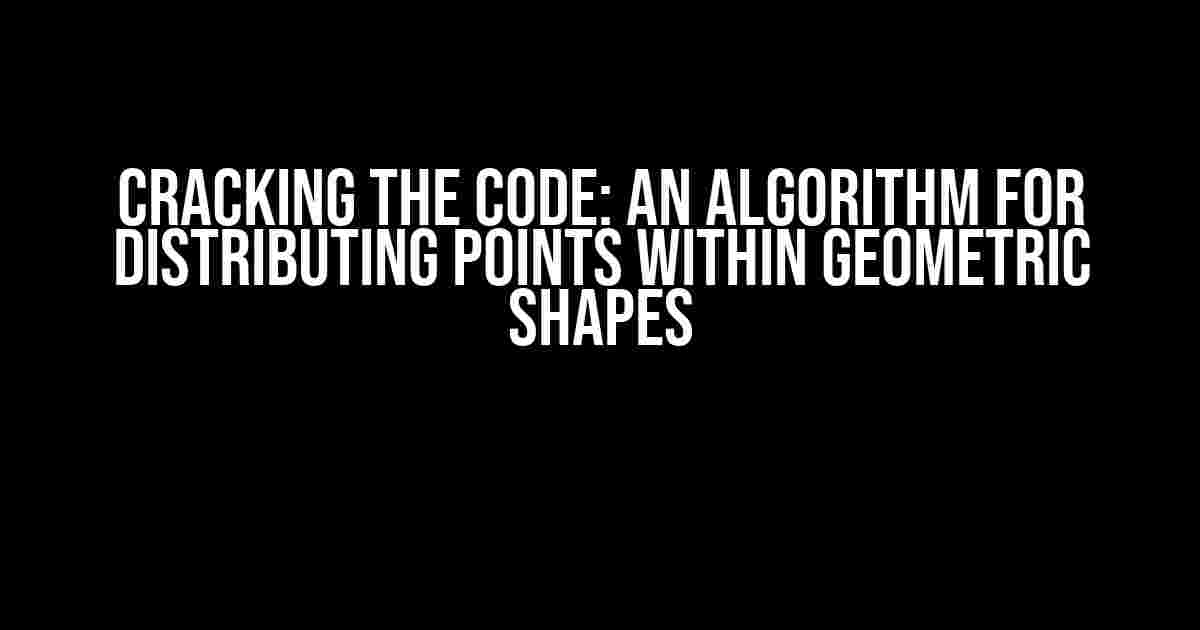Imagine you’re an architect tasked with designing a luxurious hotel lobby. You want to create a visually stunning pattern of lights on the ceiling, but you need to distribute them evenly within the complex shape of the lobby. Sounds like a daunting task, right? Fear not, dear reader, for we’re about to embark on a thrilling adventure to explore the algorithm for distributing points within geometric shapes!
What’s the Problem, Anyway?
In various fields like architecture, engineering, computer science, and even art, we often encounter the need to distribute points within geometric shapes. This can be for aesthetic purposes, like our hotel lobby example, or for functional reasons, such as placing sensors in a robotics application. The challenge lies in finding an efficient algorithm that can handle complex shapes and ensure an even distribution of points.
The Problem’s Roots: Poisson Disk Sampling
One of the most popular methods for distributing points within geometric shapes is Poisson Disk Sampling (PDS). This technique involves generating points randomly, but with a twist: each point must be a certain distance away from its nearest neighbors. This ensures a more even distribution of points, but it can be computationally expensive for complex shapes.
// A simple PDS implementation in pseudo-code
function poissonDiskSampling(shape, r) {
const points = [];
const queue = [shape.center];
while (queue.length > 0) {
const point = queue.shift();
if (pointIsInsideShape(point, shape) && !pointIsTooClose(points, point, r)) {
points.push(point);
queue.push(...getNeighbors(point, r));
}
}
return points;
}
Delaunay Triangulation to the Rescue!
While PDS is effective, it can be slow for complex shapes. That’s where Delaunay Triangulation (DT) comes in. By dividing the shape into triangles, we can use the resulting mesh to distribute points more efficiently. The key idea is to find the circumcircle of each triangle and place a point at its center. This approach ensures a more even distribution of points, especially in areas with high curvature.
// A Delaunay Triangulation implementation in pseudo-code
function delaunayTriangulation(shape) {
const triangles = [];
const points = [];
// Initialize the triangulation with a supertriangle
const superTriangle = getSuperTriangle(shape);
triangles.push(superTriangle);
while (triangles.length > 0) {
const triangle = triangles.shift();
points.push(triangle.center);
// Remove triangles that are no longer necessary
triangles = triangles.filter((t) => !isTriangleInsideTriangle(t, triangle));
}
return points;
}
The Algorithm: A Hybrid Approach
Now that we have PDS and DT, let’s combine them to create a hybrid algorithm that leverages the strengths of both approaches. The idea is to use DT to generate an initial distribution of points, and then refine it using PDS.
// The hybrid algorithm implementation in pseudo-code
function distributePointsWithinShape(shape, r) {
const points = delaunayTriangulation(shape);
// Refine the distribution using Poisson Disk Sampling
while (true) {
const newPoints = [];
for (const point of points) {
const neighbors = getNeighbors(point, r);
for (const neighbor of neighbors) {
if (!pointIsTooClose(points, neighbor, r)) {
newPoints.push(neighbor);
}
}
}
if (newPoints.length === 0) break;
points = points.concat(newPoints);
}
return points;
}
Real-World Applications and Examples
Our algorithm has numerous applications in various fields:
- Computer-Aided Design (CAD): Evenly distribute points within complex shapes for design optimization and aesthetics.
- Robotics and Sensor Placement: Place sensors in a way that maximizes coverage and minimizes overlap.
- Computer Graphics and Animation: Create realistic distributions of objects within scenes for film and video games.
- Urban Planning and Architecture: Optimize the placement of buildings, roads, and other infrastructure within complex city layouts.
| Shape | Points |
|---|---|
| 25 | |
| 36 | |
| 49 | |
| 100 |
Conclusion
We’ve cracked the code and developed an efficient algorithm for distributing points within geometric shapes! By combining the strengths of Poisson Disk Sampling and Delaunay Triangulation, we’ve created a powerful tool for various applications. Remember to choose the right approach based on your specific use case and shape complexity. Happy coding, and don’t forget to share your points-based masterpieces!
Further Reading and Resources
For those interested in diving deeper into the world of point distribution algorithms, here are some resources to get you started:
- “Poisson Disk Sampling” by Bridson et al.
- “Delaunay Triangulation and Mesh Generation” by earson et al.
- Algorithmist’s GitHub repository for various algorithms, including point distribution methods
Frequently Asked Question
Get ready to dive into the world of geometric shapes and point distribution algorithms!
What is the goal of an algorithm for distributing points within geometric shapes?
The primary objective of an algorithm for distributing points within geometric shapes is to place a given number of points inside the shape, ensuring that the points are evenly spaced and follow a specific pattern, such as a grid or a random distribution. This is crucial in various fields like computer graphics, game development, and geographic information systems (GIS).
What are some common geometric shapes used in point distribution algorithms?
Some common geometric shapes used in point distribution algorithms include triangles, quadrilaterals, polygons, circles, and ellipses. These shapes can be 2D or 3D, and the algorithms can be applied to various domains, such as architecture, engineering, and video game development.
How do point distribution algorithms ensure even spacing between points?
Point distribution algorithms use various techniques to ensure even spacing between points, such as grid-based methods, Voronoi diagrams, and Poisson disk sampling. These methods aim to minimize the distance between points while avoiding clustering and maintaining a consistent density throughout the shape.
What are some real-world applications of point distribution algorithms?
Point distribution algorithms have numerous real-world applications, including terrain generation in video games, architectural design, geographic information systems (GIS), computer-aided design (CAD), and even in the creation of virtual reality (VR) and augmented reality (AR) experiences.
Can point distribution algorithms be used for 3D shapes as well?
Yes, point distribution algorithms can be extended to 3D shapes, enabling the distribution of points within three-dimensional objects, such as cubes, spheres, and polyhedra. This is particularly useful in fields like computer-aided design (CAD), 3D modeling, and scientific simulations.
